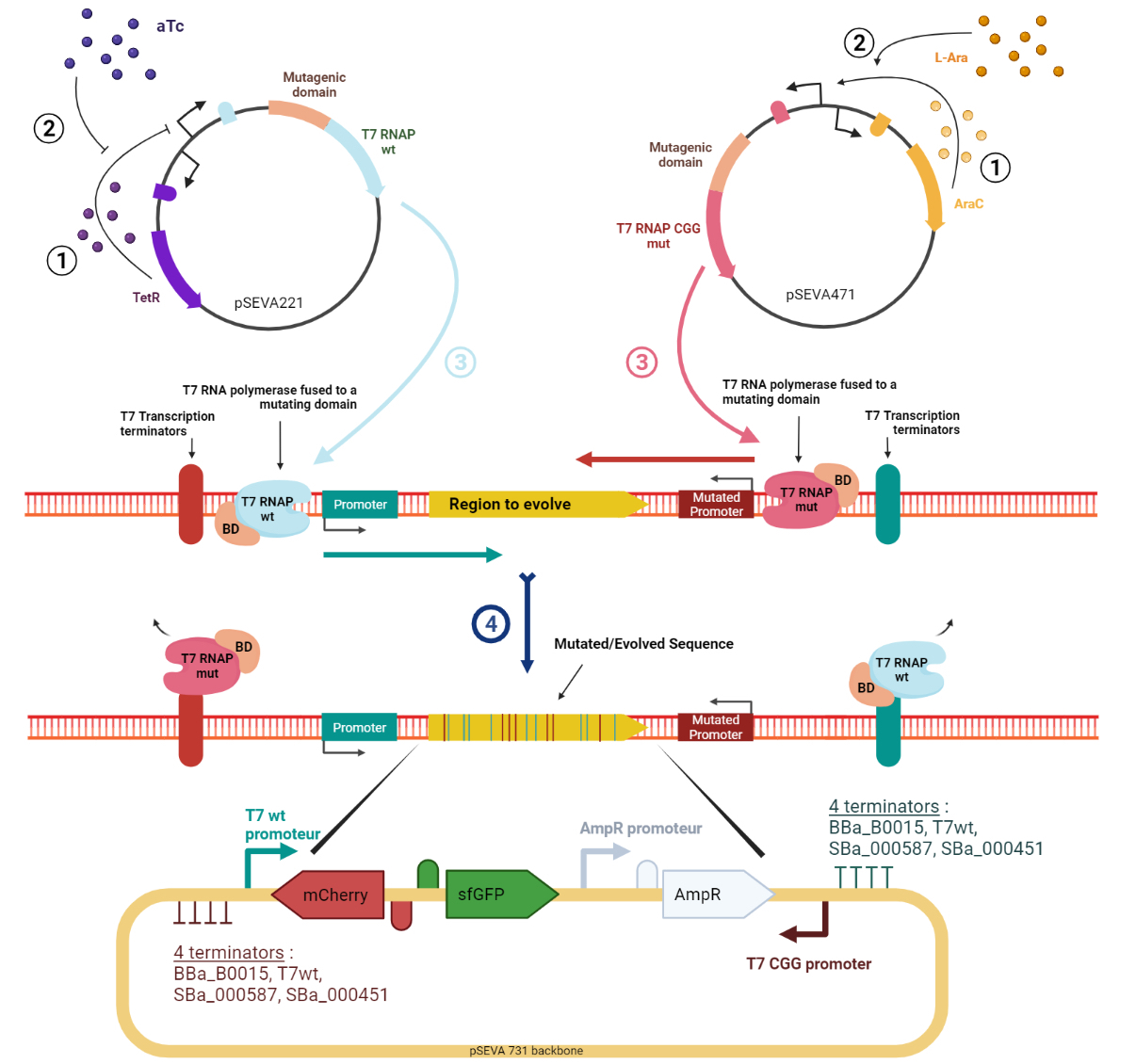Part:BBa_K3766111
mCherry sfGFP AmpR
This is a composite part composed of three genes: mCherry, sfGFP AmpR, that we used as reporters of our Evolution.T7 targeted directed evolution system.
Usage and Biology
Evolution.T7 is a targeted directed evolution system based on the orthogonal RNA polymerases of phase T7 (T7RNAP) [1–4]. Mutagenesis is performed by a mutator protein (e.g. base deaminase) linked to the polymerase and, thanks to T7RNAP’s specificity towards the T7 promoter, it is possible to target the mutagenesis to a sequence flanked by T7 promoter and terminator. The high processivity of the T7RNAP allows for mutagenesis to occur over a long sequence of DNA without showing bias to the distance from the promoter. However, a bias was observed in the current tools [1–4] which was that mainly only one of the strands of DNA would be targeted for mutation at each mutation cycle, resulting in poorly diversified sequences. To address this, we designed the target sequence putting the T7 promoter upstream and downstream of the gene to have polymerases moving in both directions and generating mutations in both strands. This approach has been tried by Moore ‘’et al.’’ [1] but they found out that this would lead to the accumulation of A:T pairs along the gene. Also, we assumed that owing to the high processivity of T7RNAP, often there are active transcription machinery moving in both directions and thus, there is a high probability of collision resulting in the reduced processivity of both complexes. This phenomenon can lead to the accumulation of mutations on one DNA strand in one part of the gene and more mutations on the other strand in the other part. To bypass this, our innovative design takes advantage of a mutant T7RNAP that has higher specificity to an altered T7 promoter sequence [5]. The canonical and mutant T7 promoters are installed upstream and downstream of the gene, respectively (Figure 1). The wild-type T7RNAP expression is induced by tetracycline, while the mutant T7RNAP is induced by arabinose. In addition. to enhance the mutation rate and diversity, our tool expands the panoply of base base deaminases by including, apart from the ones used in previously described methods (AID, pmCDA1, rAPOBEC1, TadA*), three of their potent variants ABE8.20m [6], evoAPOBEC1-BE4max [7], evoCDA1-BE4max [7]. In addition to higher efficiency, these variants generate mutations without being affected by the base context of the substrate, resulting in higher target compatibility.
Figure 1. Schematic representation of the Evolution.T7 system. T7RNAP is the natural T7 RNA polymerase that transcribes from the T7wt promoter. T7RNAP-CGG-R12-KIRV is a mutated T7 RNA polymerase version that transcribes from the mutant T7CGG promoter. Image created in BioRender.com.
As a proof of concept of our targeted directed evolution system, Evolution.T7, we used this part to evolve the ampicillin resistance gene, AmpR, in a way that it would confer resistance against aztreonam, which is a powerful antibiotic against ampicillin resistant bacteria [8-10]. The collection of AmpR variants evolved to confer resistance to aztreonam (AZT-1 to AZT-34) is available in Parts Registry under the accession numbers BBa_K3766151 to BBa_K3766184.
References
[1] Moore CL, Papa LJ, Shoulders MD. A processive protein chimera introduces mutations across defined DNA regions in vivo. Journal of the American Chemical Society (2018) 140: 11560–11564.
[2] Álvarez B, Mencía M, de Lorenzo V, Fernández LÁ. In vivo diversification of target genomic sites using processive base deaminase fusions blocked by dCas9. Nature Communications (2020) 11: 6436.
[3] Park H, Kim S. Gene-specific mutagenesis enables rapid continuous evolution of enzymes in vivo. Nucleic Acids Research (2021) 49: e32.
[4] Cravens A, Jamil OK, Kong D, Sockolosky JT, Smolke CD. Polymerase-guided base editing enables in vivo mutagenesis and rapid protein engineering. Nature Communications (2021) 12: 1579.
[5] Meyer AJ, Ellefson JW, Ellington AD. Directed evolution of a panel of orthogonal T7 RNA polymerase variants for in vivo or in vitro synthetic circuitry. ACS synthetic biology (2015) 4: 1070–1076.
[6] Gaudelli NM, Lam DK, Rees HA, Solá-Esteves NM, Barrera LA, Born DA, Edwards A, Gehrke JM, Lee S-J, Liquori AJ, Murray R, Packer MS, Rinaldi C, Slaymaker IM, Yen J, Young LE, Ciaramella G. Directed evolution of adenine base editors with increased activity and therapeutic application. Nature Biotechnology (2020) 38: 892–900.
[7] Thuronyi BW, Koblan LW, Levy JM, Yeh W-H, Zheng C, Newby GA, Wilson C, Bhaumik M, Shubina-Oleinik O, Holt JR, Liu DR. Continuous evolution of base editors with expanded target compatibility and improved activity. Nature Biotechnology (2019) 37: 1070–1079.
[8] Brogden RN, Heel RC. Aztreonam. A review of its antibacterial activity, pharmacokinetic properties and therapeutic use. Drugs (1986) 31: 96–130.
[9] Ramsey C, MacGowan AP. A review of the pharmacokinetics and pharmacodynamics of aztreonam. The Journal of Antimicrobial Chemotherapy (2016) 71: 2704–2712.
[10] Cantu C, Huang W, Palzkill T. Selection and characterization of amino acid substitutions at residues 237-240 of TEM-1 beta-lactamase with altered substrate specificity for aztreonam and ceftazidime. The Journal of Biological Chemistry (1996) 271: 22538–22545.
Sequence and Features
- 10COMPATIBLE WITH RFC[10]
- 12COMPATIBLE WITH RFC[12]
- 21COMPATIBLE WITH RFC[21]
- 23COMPATIBLE WITH RFC[23]
- 25INCOMPATIBLE WITH RFC[25]Illegal AgeI site found at 299
Illegal AgeI site found at 411
Illegal AgeI site found at 1061
Illegal AgeI site found at 2732 - 1000COMPATIBLE WITH RFC[1000]
| None |

